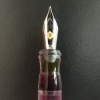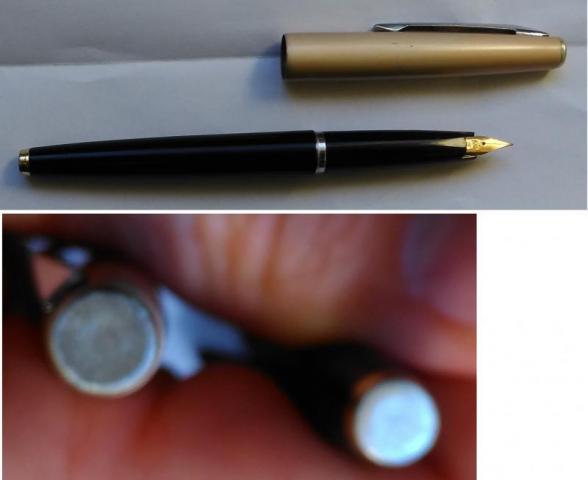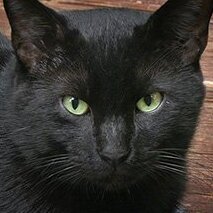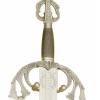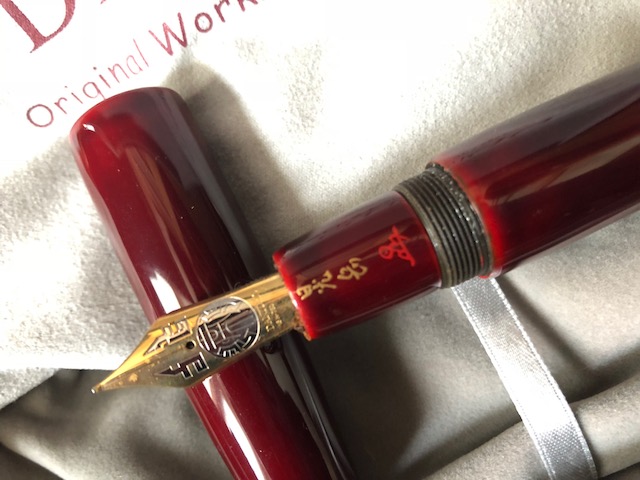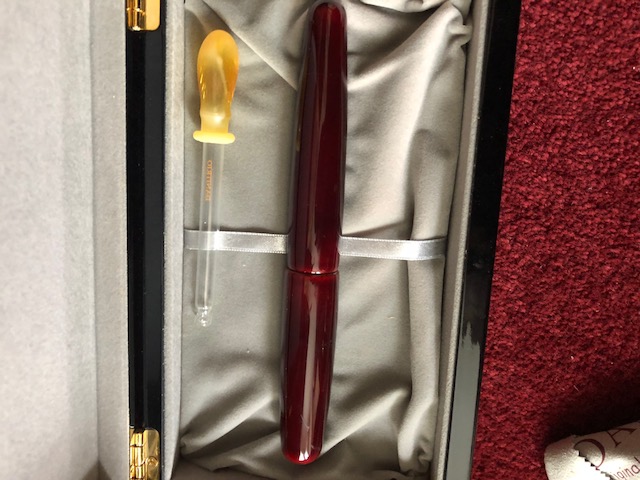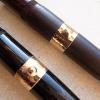Search the Community
Showing results for tags 'japan'.
-
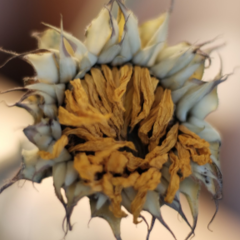
A True Souvenir From Japan: Japan Blue Oita Made (Jetlagged Quick Look)
peroride posted a topic in Fountain Pen Reviews
Background: Went to Itoya to pick up a grail before we left Japan then saw this during the wait: They had the Lamy Anniversary Bauhaus Blue edition but we went for Japan Blue instead. That terrible refrain, "I don't need another pen" follow by the follow-up analysis and sleep over/can't sleep over decision making oscillation worked its way to purchase this fine souvenir. Wanted a remembrance of our 1st time in Japan and this fit the bill: Made in JapanLove of local/regional companies, handcraftedTraditional craft of indigo and hammering metal techniqueIt's a metal Sailor to Oita Made specUniqueI wanted a Medium but the last one was only a Fine and the missus loved it too. I have to share It's more of a family pen Color: Midnight blue purple indigo. Indigenous textiles was another hobby in a past life and the tie in of anodized indigo was a great pull. Visually, it's an eyecatcher and smartphone down-res photography does not do it justice. This is an accurate observation: "...a unique beauty that cannot be explained by photography" My color range is pretty conservative so for Japan Blue to make an impression spoke volumes. The pen was paired with Sailor Shikiori Nioi-Sumire to match the indigo body. My wife has the color instinct as the ink sticker bore no shade resemblance to the actual color swatch which is much darker. Though to my old eyes and the ton of blue ink variants we have, I cannot see the specialness of Nioi-Sumire other than it's the best Sailor match we could see. Material/handling: Hammered aluminum body, light unposted, slightly backweighted posted. Black plastic section is comfortable. I've only handled Classic Pens silver Sailor so if there are other metal Sailors let me know. Thankfully it's not heavy I'm a serial poster but am a little concerned about the design choice of 2 pins to hold the cap in place which posts with a click. I understand the choice over friction fit posting but it is an area for potential flaw should the pins loosen over time. I'll probably be dead before it fails though and luckily it is a great writer unposted. Nib: As stated, it is a Sailor Fine though I am fond of Sailor M at least the KOP version. Japan Blue completes my range: EF, F, MF, M Overall impression: Japan Blue is a great souvenir of our time in Japan whose craft, people and culture is much to be remembered and thankful for. Manufacture is backed by an established company, Sailor and their quality is consistent and reliable. Here are some relevant links: https://www.fountainpennetwork.com/forum/topic/345076-wancher-sailor-limited-edition-hammered-metal-finish/https://oitamade.jp/topics/news/292Arigato! -
I wasn't 100% sure if I should start this thread in the repair or Japan forum. I chose Japan because it is not about repairing a Sailor pen but sending it to Sailor for repair. I thought I would post this thread to inform anyone interested of how the repair process for Sailor Pens works. I sent mine in for repair because I lost the friction-fit inner cap. This is probably a 10 cent part, but the only solution I could find was to send it to the factory for repair. After consulting the forums in this thread: https://www.fountainpennetwork.com/forum/topic/347469-sailor-inner-cap-replacement/ I contacted Itoya -- the US Sailor distributor -- via their website: itoya.com. From there, I emailed returns@itoya.com and received this email: Hi Jonny, We can help facilitate the repair with Sailor. We as the distributor is not allowed by Sailor to do any sort of repair. All repair work has to be done at the factory in Japan. It is also Sailor policy not to send just parts for replacement. The entire pen has to be sent to Japan for evaluation. Even if you are just missing the inner cap. This is to ensure that the pen is in perfect working condition once the parts are replaced and repair is completed. Below is our repair process. You will be shipping your pen to our facility in California. Once it arrives, we will send this to SAILOR Japan. Once the evaluation is completed, SAILOR will contact us with a cost estimate which we will forward to you through email. If you authorize us to have SAILOR proceed, you are responsible for this amount plus a $20.00 shipping & handling fee (these charges are typically handled by credit card - we accept Visa, MasterCard or Discover). The entire process typically takes 10-12 weeks. If you decide not to proceed with the repair, the pen will be return unrepaired and your cost will only be the $20.00 shipping and handling. Please send the entire pen to ITOYA, at the address below. Reference on the outside of the package ######### for easy identification. Itoya800 Sandhill AvenueCarson, CA 90746 Here's the timeline so far for repair: Tuesday, July 9, 2019I sent the pen to Itoya via USPS. Friday, July 12, 2019USPS let me know Itoya received the pen. Tuesday, July 16, 2019I emailed Itoya to confirm receipt since I had not heard from them. Wednesday, July 17, 2019Itoya confirmed they had received my pen. Tuesday, August 13, 2019I have not received further communication from Itoya. I assume all is moving forward and my pen is somewhere in the Pacific Ocean. I will update this thread as the process continues. In the meantime, I sent a pen to Franklin-Christoph last week for repair and have already received confirmation that it is in the mail back to me. I have also learned that Pilot has a repair tech in Lousiana. I love my Sailor, but I may choose Pilot for my next Japanese pen since they shouldn't require 10-12 weeks for a simple repair.
-
Platinum #3776 Century in Laurel Green (with gold trim) and 14K gold Fine nib now ¥8,824 (inclusive of 8% domestic consumption tax) sold and shipped by Amazon.co.jp. That's the first time I've seen any of the Laurel Green pens, which debuted at an MSRP of ¥13,000+tax, offered by a major retailer for less than ¥9,000 (but maybe I haven't been watching too closely, since I already have so many other #3776 pens with 14K gold Fine nibs).
-
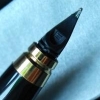
Anybody Knows This Beauty? Is It From China, Korea Or Japan? What Is This Pen?
Lodzermensch posted a topic in Fountain & Dip Pens - First Stop
What is this pen? What is the brand / producer / origin? What model is this? This is a pen given to me by my father in early 80-ties. I used it for a couple of years as my every day pen. I cannot identify the producer nor the model. Must be produced somewhere in 1970-ties ot late 1960-ties? Much likely to be from China ? Maybe Japan? Maybe someone is able to read the signature on the nib? -
Watched this wonderful show on NHK World last evening. The topic was Japanese stationery and what a great insight as to why many think Japan has some of the best stationery, office supplies and pens in the world. It will air online until March 7th, 2019. https://www3.nhk.or.jp/nhkworld/en/ondemand/video/2046063/
-
desaturated.thumb.gif.5cb70ef1e977aa313d11eea3616aba7d.gif)
Another Rakuten Global Express 30%-Off International Shipping Promotion
A Smug Dill posted a topic in Market Watch
Lucky me, Rakuten Global Express (RGX) – the Japanese reshipping service associated with Rakuten Global Market and Rakuten Ichiba – has activated another 30%-off international shipping charges promotion campaign in the last couple of hours. It's something RGX does from time to time throughout the year. I bought some items on Amazon.co.jp yesterday, and unfortunately these days the only way to get the goods here to Australia is to use a reshipping service, at my additional expense as the consumer; that often kills good deals on Amazon.co.jp and Rakuten for products that are difficult and/or expensive (due to profiteering by commercial importers) get here. It will still be costly, but that 30% discount could well amount to A$15 or more, and make a significant difference if one is just buying $150 worth of stuff. I think the terms and conditions of RGX's service is that it will hold goods it received on behalf of registered customers for up to a month, and I was hoping that something like this would come up soon. Fortunately, I didn't have to wait that long! Now, to see what else I might want to add to this shipment; there's essentially a 'flagfall' charge of ¥2,000 – about A$25.56 – for reshipping goods to Australia by EMS service, on top of weight-based charges. However, I've been very impressed with the speed of delivery on the occasions I've used RGX's service; both times the parcels were ready to collect in my Australia Post Parcel Locker within the week. -
Concise, minimalistic presentation, useful for comparison. Text is laconic somehow poetic never ever negative. Tactful. I've been following his ink presentations for a year. One ink every day. 654 inks till now. Many Sailor LEs. Does have a search engine. You can use google translation. http://happyinkdays.hatenablog.com This one from Taiwan. On tweeter. Totally mute. https://twitter.com/yveslee_TW Thanks to both of them, if they read me. I really enjoy their work. David.
- 9 replies
-
- sailor inks
- sailor
-
(and 6 more)
Tagged with:
-
Hello, I am in Tokyo now and I am looking for a Sailor quality pen. Do you know where is the best store in Tokyo to buy a Sailor pen? Thanks!
-
Dear fountain pen friends, a friend of a friend of mine is currently staying in Tokyo. Do you know good places where to buy inks in Tokyo for a good price? I'm thinking about Sailor and Iroshizuku inks. Any other advice what to get in Tokyo stationery-wise? Thank you!
-
In one of the world's largest cities, there always seems to be a place to take a break. At the Hakusan Shinto shrine in Tokyo. A week in Japan makes me think stationery stores are the retail urban planning equivalent of zen gardens. They provide an analog break in days filled with digital noise. We have only a few stores left in the United States, in Appleton, Wis., and Little Rock, Ark., of all places, and Houston, and Nashville, and another north of Pittsburgh. A couple in New York and New Jersey. Two in Maryland and one in Washington, DC, and that’s about it. I’m probably leaving out a couple, but my point is that in a really big country, there are fewer than a dozen bricks-and-mortar stationery stores. Unless you count Staples and OfficeMax, which are great for laserjet paper, printer cartridges, and office chairs. Japan, on the other hand, is stationery mecca. I was in meetings in Osaka where team leaders handed out agendas and summaries in elegant transparent folders, and erasable gel ink pens, and we realized that every one of us around the table was a geek who, in elementary school, undoubtedly loved the fragrance of promise and hope in a new box of yellow No. 2 pencils. Kyoto In Kyoto, the spiritual heart of Japan, there are more than 1,600 Buddhist temples and 400 Shinto shrines. TAG’s headquarters stationery store is in Kyoto, and there are five other TAG shops around the city, filled with paper for calligraphy and art projects and school assignments, and racks of washi tape and fountain pens. Kyoto specialists in natural dyes, who got their training in textiles, created the TAG line of inks. Remember indigo? Around 900 AD, people in the imperial court of Keian in Heian-kyō, the former name for Kyoto, fermented leaves to produce indigo. I digress, but here’s my point: if you really like writing, it’s entirely possible that, like Matsuo Basho, your heart is in Kyoto. On a walk through the Arashiyama bamboo grove, I’m talking with a friend about how Japan offers up so many details that would make great visual pauses in films. Breathing space. They’re like the short musical interludes, sometimes called buttons, in radio news broadcasts. She asks why I like calligraphy. It’s an analog break from digital chores, I tell her, and she responds, “Oh, like a button.” A few meters away, we walk by a home where the poet Matsuo Basho hung out with one of his students. Even in Kyoto -- Hearing the cuckoo’s cry -- I long for Kyoto. -- Matsuo Basho Tokyo One of the great things about Tokyo is that even though it’s one of the 10 largest cities in the world, with almost 14 million people, there always seems to be a green place to take a break -- a playground or a garden, a bench on a shady patch of street, or a shrine with a fountain for prayer. Stationery shops are air-conditioned and filled with students and bookish people, and they are wonderful quiet spaces. I found myself in two of them, the Maruzen bookstore, located a hundred meters from Tokyo’s central station, and the TAG store on Tennouzu Isle. Maruzen is a Japanese chain, and half a floor in the main Tokyo store is devoted to stationery, pens, and inks. Lovely display cases show pens from global brands as though they are objects in a museum, all, it seems, at retail list price. But a section of ink is tucked away on one side of the pens, a closet full of colors from Pilot, Platinum, Sailor, Montblanc, Faber-Castell, and Pelikan. Hiding away in one corner are inks made for Maruzen by Sailor -- Athena sepia, and renga, an urushi red. They’re considered unobtainable everywhere else. I buy them both, again at retail price, which in the case of Japanese inks is 30 percent less than everywhere else. The notebook section offers funky composition notebooks by a brand called nanuk. I’m not sure if the paper works well with fountain pens, but they have a sample copy for testing. At the pen counter, a salesperson helpfully pulls out a Platinum Preppy pen, and as it turns out, nanuk paper is terrific. On the late afternoon of another unbelievably hot July day, I stumble upon the TAG stationery store on Tennouzu Isle, just off the monorail to Tokyo’s Haneda airport. The store offers envelopes and paper in pastel patterns of coral and indigo, designed for writing letters, lined or unlined. The store manager is playing an entire Beatles album -- Sgt. Pepper’s Lonely Hearts Club Band -- and for 20 minutes, I’m lost in a bliss of washi paper and “I’ve got to admit, it’s getting better.” Then, it gets better. Next to the cashier there’s a display of every TAG Kyoto ink, from Moonlight of Higashiyama, a brick red, to Aonibi, a blue-black. The manager gives me a pen with a glass nib for testing ink. (Let me repeat that -- they keep a glass-nibbed pen for testing inks.) I realize that one ink, Nurebairo, is a black that shades blue, with a subtle golden halo sheen. When I’m confused about whether Nurebairo actually shades blue, she explains that it depends on whether the paper is cream or stark white. Then she wraps it up, adds it to my other purchases, and agrees with me about The Beatles. I walk out onto a boardwalk and as the sun sets on Tokyo Bay, I eat a wagyu hamburger with an old friend.
- 28 replies
-
- stationery
- japan
-
(and 5 more)
Tagged with:
-
Hi all, First of all allow me to introduce myself as a recent new member to the forum and hope at least I can be a little of use to this forum. But first, I want to ask if any of the members here has had an experience buying from pensachi (through their website). I have just lately placed an order and paid but have never heard people buying stright from their website and now I am anxious whether my order will go through. Any feedback would be appreciated, thanks! (NB : f this is in the wrong sub-forum please help in moving it).
-
Hello all, I am going to spend a couple of weeks in Japan (mostly Tokyo, Kyoto and Osaka) and I plan to look at some pens over there. Does anyone know how do prices compare with Japanese pens sold at discounted prices by online US stores? E.g., the Platinum 3776 Century has, I believe, a price list of $220, yet it can be bought at Amazon for $76. Itoya has it on their website at Y 16,200 ($148). What are the chances of finding really good deals in the land where the sun does actually shine?
- 16 replies
-
- prices discounted
- japan
-
(and 3 more)
Tagged with:
-
Hi, I was hoping some of you will be able to help me. My father had a collection of fountain pens which are now in my possession. His collection includes a few very prestige pens (from what I gather), including a Danitrio. I know nothing about fountain pens, so I need some help identifying the model of this pen (pics attached). I'd like to sell this pen, however knowing nothing about it, this is pretty difficult! I'm looking for the specific name & model, and perhaps even an estimate of how much this pen was purchased for so I can gauge the price I should sell at. Saying that, should anyone be interested in purchasing, do let me know. Many thanks in advance! J
-
Does anyone know if Nikko (=Eboya) sells their marble (?) ebonite rods to other makers? I'm wondering if there are any makers -- other than Eboya -- either in Japan or overseas, which have access to this style of pen blank: https://www.nibs.com/pens/eboya/eboya-natsume-small-kumpuu-green-cc I've never seen any non-Eboya pens made of this stuff or its color variants. As nice as the Eboya pens are, it would be cool to see some designs by other makers in this material too, which is why I'm asking. Thanks!
- 6 replies
-
- nikko marble ebonite
- nikko
-
(and 3 more)
Tagged with:
-
I was wondering if anyone knew what the correct color ink is to write a thank you to a Japanese family. The note will accompany a small gift. In the States, I'd stick with black, but I'm not sure about Japan. Thank you!
-
My daughter will be in Japan, outside of Tokyo, for some time and I would like to give her specific instructions on bringing me back pens. The yen is strengthening so I am more interested in pens that are exclusive to the Japanese market than in ones that might be cheaper over there. Is my best bet to give her a budget and tell her to get pens that are exclusive to the store she is in? She'll be there long enough to search out bungbox. I wouldn't mind a Decimo in a color we can't get stateside, either. Thanks everyone!
-
I made a short blog post about vintage Japanese long short pens and some observations about them. The post has been reproduced below. Photos are from Bruno Taut. ------------------------------------------------------------------------------------------------------------------ Well, it should be are. In the Philippines, we're helped by the phenomenon known as "Japan Surplus". These are thrift shops focused on Japan-sourced (used/vintage) goods which now and then will include fountain pens from the venerable trio of Pilot, Platinum, and Sailor. If you are open to buying used goods, these are great buys because for not much money (you can get a good one for $20-30) you get a lot of pen. The ergonomics are great since the entire "section" of the pen is round, smooth, and sloping nicely toward the nib. It's also a pocket or a "long-short" pen which means it is meant to be manageable in your pocket, compact and light. These write quite well and, in terms of thickness, I find that an F (fine) nib on these will are a close approximation of needle-type gel pens like the Pilot G-Tec 0.4, while the M (medium) nibs are like 0.5 ballpoints. I caution against getting the EF/XF (extra fine) nibs because these are often too rough to be enjoyable unless you get one that is "like new". Regardless of the nib width, the ink flow on these are a very good fit with what the regular user encounters day-to-day. Outside of some glossy or coated papers like credit card receipts, these can and will replace you regular pen (and will write better than whatever pen is offered to you if you don't carry a pen). You can go to a bank and fill out a deposit slip without any of the fears commonly brought about by using fountain pens. You don't need to get a special notebook that costs more than ink. You also get a gold nib. A gold nib really isn't that important. You write with the tip of the nib which is of the same material in both gold and steel nibs, and gold nib flexibility only makes sense with flex writing, which isn't a useful feature for many people. What a gold nib does give is theoretical quality because people believe that gold nibs will last longer than stainless steel nibs, but what's more important is that if you look at the brand new market, gold nibs come at a premium (because of the appreciation of gold) and is also paired with the non-beginner pen. This means that gold nibbed pens, disregarding the nib, are of much higher quality than the bodies of steel nibbed pens. While the divide wasn't as apparent in the heyday of fountain pens, I find this distinction applicable as well to vintage pens. The plastic feels thicker, the caps close more snugly, and things generally feel made to higher standards. A good example is the Pilot Elite (of old) and the current Pilot Elite E95S. One is $30, the other is more than $130. Since fountain pen technology development is almost non-existent, outside of a newer coat of paint, heavier components, and a negligible increase in gold (14k vs 18k), it's the same pen. Both pens can use the Con-40 ink cartridge converter too, to make filling-up from ink bottles easier. Lastly, another consideration is exclusivity. There are certain circles that go gaga over new pen barrel colours and decorations (priced many times more than the base model of already expensive pens) and they justify this weakness for capitalism's snares as getting something very few people have. Yet, often, for these pens, these people will organise a group order (to save on shipping) which means a bunch of them get the same pen. With these Japanese pens, it's very unlikely you'll come across someone with the same pen, even if you mingle with local users. A pitfall though for these pens is that the dealers associated with these pens are frequently not fountain pen users, sometimes unscupulous, and this may lead to problems when trying to purchase a pen. I, personally, have never been able to find these pens in the wild, and only get to them through online buy and sell groups. Here, the dealer problems are magnified because photos are frequently very bad and requests for more photos only get you more out of focus photos. This is a big deal because one of the things you have to look at when getting old pens is the tipping. Because the tipping is what actually hits the paper and what you write with, its quality spells the difference between a good pen and a near useless one. Half of the time, these are worn down, mangled, or worse, gone! Bad photos, vague answers, and a "what you see is what you get"/"as is, where is" store model really gives you doubts about the product and doesn't really make for an enjoyable buying experience sometimes. A smaller consideration is that these pens almost always have a fingernail nib. These are very hard to dismantle (I would profusely caution against it) and so sacrifices some modularity for people who like tinkering with their pens. The design also makes cleaning take a bit more time than open nibs so it's not a good choice if you like changing inks quickly or testing inks. Of course, one workaround is to just buy more pens of this kind.
- 4 replies
-
- japan
- japan surplus
- (and 4 more)
-
Don't know if anyone else saw this, but at first I thought that it's crazy that A Silver/White Stripe Myu showed up a few months ago and then this one... and then I clicked and saw... https://www.ebay.com/itm/PILOT-Myu-WHITE-STRIPE-Fine-Print-FOUNTAIN-PEN-Used-Rare-Japan/183004040721?hash=item2a9be40e11:g:OCEAAOSwuShaUahI
-
(Disclaimer: This will be a long review of my favorite pen in my current collection. If you want to read just the review, skip to Packaging. Plus, this review is going to be picture heavy.) Introduction: India is a land of great intellectuals and the longevity of the race to reach the top is pretty staggering. May it be an exam that can decide your future or a Periodic Test in Grade 10, exams play a vital role in a student’s life in India. This holds for Indians living in abroad as well. So, it started with me studying hard for my Periodic Tests 2 and I was really hoping to top and get a pen with my own money as until now, my parents bought me all my pens and I didn’t want them to spend 343 AED (around 90 USD) for a pen. I did top my class and as promised, my parents agreed to buy me the Platinum 3776 Century after much negotiation. They expected me to go for something less expensive. But I had topped so there was no backing off. We ordered the pen late at night and my parents gave me the biggest surprise-they didn’t take a single Dirham from me. I ordered from J-subculture along with a converter and chose EMS shipping. J-Subculture took around 3 days to ship it and the pen reached me within 12 days. I was overjoyed when I returned from school and found a package from Japan on the table. Packaging: The pen was well packaged by J-Subculture. As for the pen, it came in a blue faux leather Platinum clamshell case with a white sleeve that my mom threw in the garbage. It contained a user manual, warranty card, and the pen inside a plastic sleeve. The converter came in a simple box. Right of the bat, the converter was a bit rough and I had to grease it with TWSBI silicone grease. Pen and Nib Design (9/10): The pen is named 3776 referring to the height in metres of Mt. Fuji in Japan. It sports a classic rounded top cigar shaped design. I wouldn’t go to the extent of calling it Montblanc inspired as I am pretty sure Montblanc hasn’t patented that design. Talking about patents, this pen’s cap houses the patented Slip and Seal mechanism that Platinum advertises can keep your nib from drying for upto 2 years. The threads are all smooth and you can feel the tension of the cap mechanism after about one and a quarter of a turn. The nib is quite plain with some simple engravings. It is pretty flat in design. The pen is also accentuated with some gold-plated rings and a center band that also has some engravings on it. The engraving on it could be better. I love this design unlike many others. Construction and Quality (7/10): This is a place where this pen kind of lacks behind. The pen feels pretty solidly made with some desirable heft to it. The resin also feels pretty durable, but it lacks in finishing. The pen had some scratches and two of them are noticeable when viewed right. Also, it has two seams on the section which isn’t quite troublesome but can be smoothed out. The engraving could also be better. Looks and Comfort (9/10): The Platinum 3776 Century Chartres Blue is made to look like the stained glass windows of the Chartres Cathedral in France. Most of the 3776 Century fountain pens are French themed with the exceptions of some LE’s that are themed after various locations and lakes around Mt. Fuji. The pen looks stunningly beautiful in blue with some transparency. But, there is a but. The pen looks as it is meant to look only in bright indoor light or in sunlight. Otherwise it looks like a very very deep blue, almost black, with almost no transparency. Comfort wise, the pen could be made a bit more thicker and longer. Only then would it be perfect for me. After posting, this doesn’t matter. Filling System (9/10): It is one of my favorite filling systems. A cartridge-converter is one of my favorites because it is easy to clean, disassemble and also to fill. The only disadvantage of Platinum’s proprietary converter is its small ink capacity. Also, as I mentioned, my converter was poorly greased. Writing Experience (10/10): It is hard to find faults here. The writing experience is stellar. This nib is a champ. The Medium 14 carat gold nib is pretty fine by western standards and writes very smooth with some nice feedback. The ink flow is perfect. This is my kind of nib. I prefer this to overly wet, fat and super smooth nibs. Now I need all the Platinum 3776 century pens with almost all nibs except the Course and the Music. I am not fan of ultra-wide nibs. This nib can be used for various purposes like note taking, daily writing and most importantly long writing sessions with ease. Comparisons: On comparing this pen with the TWSBI Eco and ASA Nauka, the Platinum feels a bit small in the hand and is the second most comfortable out of the three with the ASA bragging the first place. The Platinum easily has the largest nib of the bunch. Conclusion: While this pen is a favorite of mine, it is not without faults. Its construction and finishing could be better, and some minor changes could be done here and there. But these faults won’t stop me from buying the other 3776 Century pens. I need a Bourgogne next as my Chartres Blue needs a companion. Man, I need so many more pens! All the photos were taken with a Nikkon D5300 (I'm still learning to take photos this thing) on a windowsill (my favorite place for pen photography) of my 18th floor apartment with abundant sunlight. They have not been edited. Thank you for reading my review. Please leave your suggestions and comments below.
- 42 replies
-
http://i.imgur.com/WIYALJz.jpgStylo Art Karuizawa Karuizawa, about 80 miles from Tokyo, is a small town nestled on the slopes of Mount Asama, an active volcano (because: Japan). Famous for its jams and honey, you could be forgiven for thinking this green, leafy, sleepy, place was outside of time and far removed from the world, but its fingerprint on history is larger than its diminutive size: it is the only place to have hosted events at both summer and winter olympics (Tokyo 1964, and Nagano 1998); welcomed Yoko Ono, Jon Lennon and family every summer; was where the current Emperor of Japan met his wife (playing tennis); and was the location from which was sent the telegram ending WWII. Less momentously, my own family history runs long through Karuizawa. This was where my grandparents bought a house in the 1940s, where my mother and her siblings ran through the shaded gardens as Tokyo scorched beneath the scalding summer sun. My own children now play on that same moss, beneath those same trees, and so when I heard about Stylo-Art, a small pen-maker crafting their own creations in such an emotionally resonant location, I knew I had to visit. Motoshi Kazuno and I first tried to arrange a meeting 18 months ago, but Karuizawa is noticeably less in demand as a ski resort than as a summer retreat, and the Kazunos were away visiting relatives. Time passed, and this week I was finally able to make the 30-minute journey through the mountains to the hamlet Motoshi and his wife Shuko call home. Anyone familiar with Japan will understand that this was not a simple undertaking - the address (a series of concentric zones culminating in a radius of a few blocks) dropped me in a semi-rural jumble, and it was only thanks to the photograph of the house kindly sent me by Shuko that I managed to stumble on the little plot and two-story building. I pulled my car onto their driveway (or perhaps their lawn), and waited for a sprightly, deceptively young man in a grey t-shirt to wander out to investigate. This was Motoshi Kazuno, Mr. Stylo-Art himself, and his welcome could not have been warmer. http://i.imgur.com/PkJ0iHB.jpg The 'showroom'. I was invited in and, over iced green tea, learned of Motoshi's progression to pen-maker from salary-man in Tokyo, via existential angst and a short spell in carpentry. With great and well-placed pride he described how he had built, by hand, the home we now sat in as all the while, Shuko looked on with great affection. It is clear that she holds her husband's work in high esteem. http://i.imgur.com/CaQomtx.jpg Shuko and Motoshi Kazuno, and their wood collection. Throughout the living room were scattered trays of pens (most, apparently, being prepared for the upcoming San Francisco pen show) in a rainbow of colours and textures - woods and urushis - clean and ink-stained ("this one is washed with pilot blue black") - as well as maki-e work from "friends" in Wajima and Naoshima. I was led out to the workshop to see the array of woods neatly organised, the lathe and work-table, the frankly indecent collection of drill-bits ("my obsession") and was talked through the three days of work that leads to a completed pen. http://i.imgur.com/RmxWExL.jpg The worktop (and a very few of the vast collection of drill-bits). I must admit that, having browsed Stylo-Arts website, I was unmoved. All the pens seemed flat and lifeless, lacking any delicacy or soul. Nothing could have prepared me for the reality though, for the finished items are impeccably crafted with true care and attention, and each and every wood and embellishment has a unique character - a character carefully enhanced by Kazuno-sans respectful diligence. http://i.imgur.com/QZAdNKB.jpg Ink-stained and urushied pens (the ink used is for fountain pens, among them Pilot Blue-Black and Iroshizuku Momiji). http://i.imgur.com/TDM2oNp.jpgMore ornate urushi. http://i.imgur.com/AITjRAK.jpgMaki-e from Wajima and Naoshima (central two). I fell in love with so many, but he urged me to hold and study each one individually and at length, to feel the weight and density of the material, to explore the depth of the pattern, the way it reflected or absorbed the light, even to raise each pen to my nose and inhale deeply. Over time, I managed to cull from the many to the few. It was the scent that finally swung me - Japanese cedar, light and delicately veined, its gorgeously pungent aroma reminiscent of the tatami mats of my family home, and of long, hot, steaming Japanese baths as the snow falls beyond the window. http://i.imgur.com/z6Ed8w6.jpg My own shortlist. Note: the elastics denote different nib housing - grey for Pilot, red for Sailor 21k. The third from the left would become my pen. Although Motoshi-san crafts pens to accept Pilot, Sailor and Platinum nibs, since Nagahara-sans death it has become increasingly difficult to purchase Sailor nibs in any meaningful quantity. My pen required a Pilot, and so Motoshi pulled from his desk a collection of no. 5, 10 and 15 nibs, and we proceeded, as the sun lowered in the sky and a faint rain fell upon the roof, to whittle them down to a no. 10 FA that he expertly smoothed and coaxed to my hand. It was with this pen that I wrote a quick note in the Stylo-Art visitors book, and learned, with some surprise, that I was the first gaijin (foreigner) to ever make the trip and meet Motoshi and Shuko in their home. The honour was entirely mine. http://i.imgur.com/XbV814R.jpg Motoshi working on my nib.
-
So I just received a Pilot Petit from Japan and I think it's a wonderful little inexpensive pen. it writes much finer than the Varsity that I tend to use on the go (because I once lost a good pen...). Even though it is short, it fits well in my hand and I think is a great pen to live with a checkbook, wallet, or small purse. No, it doesn't write like my Sailor, but if I lose it I won't be tearing myself up.
- 12 replies
-
So I bought a pilot 742 in Morita's FP shop, then my hand received an accidental impact while writing, and now it's subtly bent in a way that means very little ink flow despite the tines looking like they should have flow under a loupe. I've tried a little diy, which didn't work, so now I'm thinking of sending it in for service. Of course I'm willing to pay b/c it was my own fault. What is the policy for matters like this? Should I contact the store?
- 4 replies
-
- customer service
- pilot
-
(and 1 more)
Tagged with:
-
Hi all, does anyone have an Obunsha Teikin pocket pen? The one with the Parker 180 style nib? How are they as writers and are there structural problems I have to be aware of like an easily cracked section, etc.? I'd also like to ask if anyone knows the going rate for these, if user grade. I checked eBay and only found one listing (for bidding). Attached is a photo of the pen from the seller. The Teikin is the one second from the bottom, alongside a Platinum DP-50, a no name pen, a Pilot DPP-100, and a Platinum DP-800 (or an older version of it). Thanks!
-
To me, the nib maybe looks bent?
- 7 replies
-
- pilot
- pilot custom
-
(and 3 more)
Tagged with:
-
Hi all, I am being offered this pen but neither the seller nor myself is sufficiently knowledgeable about the pen in question. I remember seeing this pen before on FPN but can't find the post. We are interested in the relative production era of the pen, if it's a good pen, and if modern Pilot converters will fit. Any help/leads are much appreciated! UPDATE: found it
- 7 replies
-
- pilot
- pen identification
-
(and 2 more)
Tagged with:

